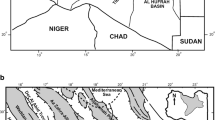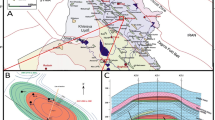Abstract
In this study, geochemistry analysis of oil and source rock extracts from different fields of Basra and Amara oil fields is implemented. Results indicate that the type of producing oil rocks are marine algae carbonate type II rocks and no contribute from terrestrial sources. These rocks are deposited under marine environment (> 150 m deep) and have normal saline and reduced conditions. No biodegradations are observed in the studied oil. The correlation of oil–oil exhibits that the oils have the same group and family and back to the same rock. On the other hand, the correlation between oil and source rock demonstrates that both of them have the same geochemical characteristics. The results of isotopic analysis of oil show so that source rocks of oil are marine mature rocks and have high sulfur content with API in range (15–48).

















Modified after Tissot and Welte (1984)

Similar content being viewed by others
References
Bray EE, Evans ED (1961) Distribution of n-Paraffins as a Clue to recognition of Source beds. Geochim Cosmochim Acta 22:2–15
Buday T, Jassim SZ (1987) The regional geology of Iraq, Vo/.2: tectonism, magmatism and metamorphism. Publication of GEOSURV, Baghdad
Connan J, Bouroulles J, Dessort D, Albrecht P (1986) The microbial input in carbonate-anhydrite facies of a sabkha palaeoenvironment from Guatemala: a molecular approach. Org Geochem 10:29–50p
Fan P, Philp RP, Lezhenxin YuX, Ying G (1991) Biomarker distributions in crude oils and source rocks from different sedimentary environments. Chem Geol 93:61–78
Fu J, Sheng G, Xu JA et al (1990) Application of biological marker in the assessment of paleoenvironments. Org Geochem 16:769–779
Grantham PJ, Wakefild LL (1988) Variations in the sterane carbon number distributions of marine source rock derived crude oils through geological time. Org Geochem 12:61–73
Holba AG, Ellis L, Dzou IL, et al (2001) Extended tricyclic terpanes as age discriminators between Triassic, early Jurassic and middle- late Jurassic oils. In: Presented at the 20th International meeting on Organic Geochemistry, 10-14 September, 2001, Nancy, France
Hughes WB, Holba AG, Mueller DE, Richardson JS (1985) Geochemistry of greater Ekofisk crude oils. In: Thomas BM (ed) Geochemistry in exploration of the Norwegian Shelf. Graham and Trotman, London, pp 75–92
Katz BJ, Elrod LW (1983) Organic geochemistry of DSDP site 467, offshore California, middle Miocene to lower Pliocene strata. Geochim Cosmochim Acta 47:389–396
Li JG, Philp RP, Mengzifag et al (2005) Aromatic compounds in crude oils and source rocks and their application to oil-source rock correlations in the Tarim basin, NW china. J Asian Earth Sci 25:251–268
Mello MR, Telnaes N, Gaglianone PC et al (1988) Organic geochemical characterization of depositional paleoenvironments in Brazilian marginal basins. Org Geochem 14:529–542
Moldowan JM, Seifert WK, Gallegos EJ (1985) Relationship between petroleum composition and depositional environment of petroleum source rocks. AAPG 69:1255–1268P
Moldowan JM, Sundaraman P, Scholl M (1986) Sensitivity of biomarker properties to depositional environment and/or source input in lower Toarcian of S. W. Germany. Org Geochem 10:915–926
Moldowan JM, Dahl J, Jacobson SR, Huizinga BJ, Fago FJ, Shetty R, Watt DS, Peters KE (1996) Chemostratigraphic reconstruction of biofacies; molecular evidence linking cyst-forming dinoflagellates with Pre-Triassic ancestors. Geology 24:159–162
Peters KE, Moldowan JM (1991) Effects of source, thermal maturity, and biodegradation on the distribution and isomerization of homohopanes in petroleum. Org Geochem 17:47–61
Peters KE, Walters CC, Moldowan JM (2005) The biomarker guide: biomarker and isotopes in petroleum exploration and earth history, vol 2. Cambridge University Press, pp 475–1155
Philippi GT (1974) The influence of marine and terrestrial source material on the composition of petroleum. Geochim Cosmochim Acta 39:947–966
Philp RP (2007) Petroleum and reservoir geochemistry for exploration geologists, geochemists and engineers. Elsevier Publishing House
Philp RP, Gilbert TD (1986) Biomarker distributions in Australian oils predominantly derived from terrigenous source material. Org Geoch 10:73–84
Picha FJ, Peters KE (1998) Biomarker oil –to –source rock correlation in the western Carpathianes and their foreland. Czech Republic. Pet Geosci 4:289–302
Riolo J, Hussler G, Albrecht P, Connan J (1986) Distribution of aromatic steroids in geological samples: their evaluation as geochemical Parameters. Org Geochem 10:981–990
Scalan RS, Smith JE (1970) An improved measure of the odd-to even predominance in the normal alkanes of sediment extracts and petroleum. Geochim Cosmochimica Acta 34:611–620
Seifert WK, Moldowan JM (1978) Application of steranes, terpanes, and monoaromatics to the maturation, migration and source of crude oils. Geochim Cosmochim Acla 42:77–95p
Seifert WK, Moldowan JM, Jones RW (1980) Application of biological marker chemistry to petroleum exploration. Proceedings of the Tenth world petroleum congress. Bucharest, Romania. September, 1979. Paper sp8, Heyden, pp.424-440
Sofer Z (1984) Stable carbon isotope compositions of crude oils: application to source depositional environments and petroleum alteration. Am Assoc Pet Geol Bull 68:31–49
Subroto EA, Alexander R, Kagi RI (1991) 30-Norhopanes: their occurrence in sediments and crude oils. Chem Geol 93:179–192
Ten Haven HL, Rullkötter J (1988) The diagenetic fate of taraxer-14-ene and oleanene isomers. Geochim Cosmochim Acta 52:2543–2548
Tissot BP, Welte DH (1984) Petroleum formation and occurrence. Springer-Verlag, New York
Author information
Authors and Affiliations
Corresponding author
Additional information
Publisher's Note
Springer Nature remains neutral with regard to jurisdictional claims in published maps and institutional affiliations.
Rights and permissions
About this article
Cite this article
Handhal, A.M., Al-Shahwan, M.F. & Chafeet, H.A. Applications of biomarker and geochemical characterization of crude oil for Mesopotamian basin, Southern Iraq. Model. Earth Syst. Environ. 6, 215–233 (2020). https://doi.org/10.1007/s40808-019-00673-0
Received:
Accepted:
Published:
Issue Date:
DOI: https://doi.org/10.1007/s40808-019-00673-0




